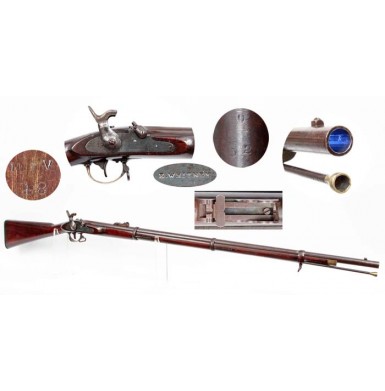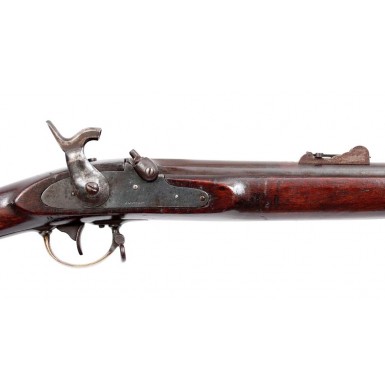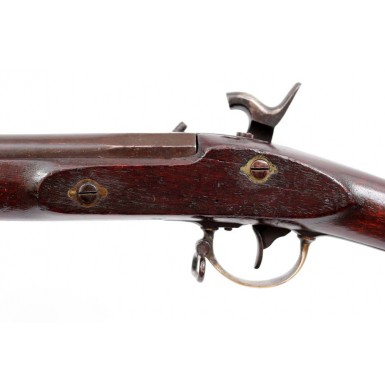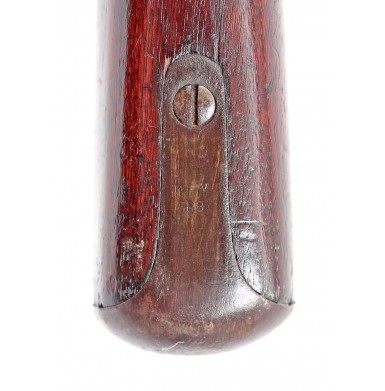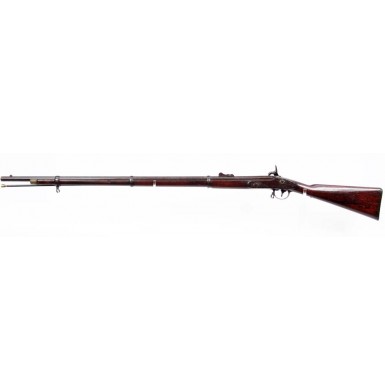The military pattern arms produced by the Eli Whitney Jr. company of New Haven, CT are some of the most interesting and intriguing arms to be produced during the mid-19th century. While the guns produced on contract for the US government are well documented, it was his second class (often called “good & serviceable” arms) that provide the most depth of variety and interesting research potential for the arms collector and historian. At the conclusion of Whitney’s contract to provide US M-1841 “Mississippi” rifles to the US Ordnance Department, Whitney opined that the strict standards of gauging and quality control that the rifles were subjected to during government inspections resulted in the multi-year, 15,000 rifle contact being a money losing proposition for him. His solution was to manufacture slightly lower quality guns, that would not be subjected to the stringent inspection standards of the US government, and sell them to the various state and local militias in the United States. Often these guns greatly resembled standard production military arms, but with Whitney manufacturing short cuts. These included the use of non-interchangeable parts, and often the use of condemned, remanufactured, repurposed and surplus gun parts as well. Some of the patterns were actually of Whitney’s own design, like his “Enfield” series of rifle muskets, which bore only the most minor resemblance to the British long arms that they were patterned after, but were manufactured with many surplus components that had been intended for use in the building of P-1853 Type II Enfield Rifle Muskets. During the Crimean War, the British government had contracted with the firm of Robbins & Lawrence of Windsor, VT to produce the current pattern P-1853 Enfield Rifle Musket. That “current pattern” is known to collectors as the Type II, and featured solid barrel bands, retained by band springs. For a variety of reasons, including the early end to the Crimean War, the cancellation of the British contract and multiple economic factors, the firm of Robbins & Lawrence went bankrupt in October of 1856. For nearly two years the British government ran the factory (possibly to recoup investments in arms that had yet to be delivered), but in June of 1858 decided to end operations and to sell the fixed assets of the company at auction. Eli Whitney Jr. attended this auction (no doubt in the front row), and purchased thousands of parts originally intended for the manufacture of the Type II P-1853 Enfield Rifle Musket. Among the items purchased by Whitney were at least 5,000 sets of solid Enfield pattern barrel bands, several thousand Enfield pattern rifle stocks that “would not pass Government inspection”, as well as many pieces of small work (butt plates, screws, escutcheons, etc.) in both finished and rough states of production. It appears that he also obtained at least some stocks and barrels that were also in rough states and unfinished, as well as some condemned barrels. This interesting assortment of parts would become the basis for Whitney’s “Enfield” series of long arms, which included at least four major variations of 33” barreled “short” rifles and a 40” barreled rifle musket. Like most Whitney arms that were not produced for a US government contract, there were often small variations in furniture, hardware and sights, as Whitney utilized parts on hand, changing components when the supplies of one particular part were used up. Between 1860 and 1863, Whitney produced somewhere between 3,300 and 3,500 of his “Enfield” rifle muskets. Other than having a general appearance similar to the Enfield, the guns were really an amalgamation of parts available to Whitney. The guns had 40” long, .58 caliber barrels that generally resembled that of the US M-1855 and M-1861 series of muskets, with round bolsters with clean out screws. Like most Whitney arms, the gun barrels were batch or serial numbered with an alphanumeric mark on top, behind the rear sight. Most of the barrels were rifled with the typical Whitney 7-groove rifling, with a slow 1:72” twist, appropriate for elongated ball ammunition. The muskets either had a long-base Whitney designed rear sight that resembled that of the P-1853 Enfield and early US M-1855s, or had a Whitney “Mid-Range” rear sight that was a single L-shaped leaf with aperture that was mounted in a base similar to the US M-1858 and M-1861 rear sight. The front sight/bayonet lug was of the US pattern, with the outer diameter of the barrel being designed to accept either US M-1855 or British P-1853 pattern socket bayonets. The locks were a uniquely Whitney design. They were flat and were flush mounted in the mortise with a rounded rear, and an odd projection between the bolster and the hammer. The hammers were similar to US M-1855 and M-1861 hammers in profile, but again, distinctly Whitney. The lock was secured by two bolts that passed through brass lock escutcheons with rounded ears, similar to the British Enfield design, but again, slightly different. The trigger guard was more similar to US than British designs, in that it was two piece with the guard bow attached to a separate trigger plate. However, the bow was made of brass and the plate was iron. The brass guard bows were likely overruns from the US M-1841 Mississippi rifle contract, as they are of that exact pattern. The stock had either a Whitney style forend cap or a British style brass Enfield cap, apparently based upon availability. A pair of sling swivels were provided, one on the face of the trigger guard bow and one on wide upper barrel band. The two types of ramrods that were provided with the guns were distinctly Whitney designs. Both had steel shanks and brass heads. One style had a cupped, semi-tulip shaped head similar to those on US M-1855 and M-1861 rifle muskets, and the other had a sort of trumpet style brass head, left over from M-1841 rifle production. The stocks were modified P-1853 Enfield stocks, altered to fit the components that Whitney installed in them. While the majority of the guns appear to have been finished bright, at least some (if note more) were apparently blued, as a handful of extant examples retain at least portions of their original, period blued finish. This finish would have been appropriate if Whitney was really trying to pass these second class arms off as real P-1853 Enfield Rifle Muskets.
While the guns were hardly uniform and followed no specifically established military pattern, Whitney managed to sell some 3,300-3,500 of them between 1860 and 1863. His largest customer was the state of Maryland, who ordered 2,000 of the guns immediately after the John Brown raid on the Harpers Ferry Arsenal. Various sources note that the guns were delivered in 1861 and used to arm the Maryland Volunteer Militia. According to Flayderman’s Guide to Antique American Arms, some 370 of those guns were captured by southern sympathizers during the April 19, 1861 riots in Baltimore. In November of 1860 the state of Georgia contracted for 1,700 of the guns, but it is believed that no more than 1,225 were actually delivered. In late 1860, the Clarke County, Mississippi militia (known as the Enterprise Guards) purchased 75 of the Whitney Enfield rifle muskets. The “Enterprise Guards’ eventually became the core of Company B of the 14th Mississippi Volunteer Infantry. The US Ordnance Department acquired 100 of the guns on the open market through Schuyler, Hartley & Graham of New York, purchasing them on August 10, 1861. After the outbreak of hostilities, it appears that some smaller amounts of the guns were sold through agents such as William Read & Son and Fitch & Waldo.
The Whitney Enfield Rifle Musket offered here is in about FINE overall condition. The gun is a classic Whitney pattern Enfield with a full-length, 40” 7-groove barrel, brass nose cap, brass triggerguard and buttplate, brass tipped Whitney rammer and a long-range Whitney rear sight. The gun retains about 30% of what appears to be its original, period blued finish on the surface of the barrel and closer to 70%+ underneath, where it has been protected by the stock. The balance of the barrel and the solid, Enfield pattern barrel bands, show a lightly oxidized plum brown patina that is very attractive. The barrel is unmarked, other than with the serial number O / 52 on top, behind the front sight. The bore of the gun is in about VERY GOOD condition. It retains strong 7-groove rifling, but is somewhat dark and dirty and shows lightly scattered pitting along its entire length, with a few smaller patches of more moderate roughness. The barrel shows a single narrow impact nick, behind the upper barrel band that appears to have been result of an edged weapon strike. The lock of the gun is crisply marked in a single line, forward of the hammer: E. WHITNEY. The lock retains about 50%+ of its original blued finish as well. The lock functions flawlessly on all positions, crisply engaging the half cock and full cock positions, and responds to the trigger, as it should. The gun retains its Whitney pattern, long base, long-range rear sight, as well as the front sight/bayonet lug. Both sling swivels are present on the gun, and the original Whitney ramrod with a brass tulip shaped head is present in the channel under the barrel. The rod is full length and retains good threads at its end. The brass furniture all has a deep, uncleaned patina that is very attractive. The top of the brass buttplate tang is stamped in two lines: M V / 48. This almost certainly stands for “Maryland Volunteers’ with the rack number 48 underneath, but it is possible that it stands for “Mississippi Volunteers”. Based upon the large number of these guns sold to Maryland in 1860 (more than half of the total production), I have to assume that this marking references the Maryland Volunteer Militia that was armed with these rifle muskets. All of the wood to metal fit is quite good and the overall quality is actually a little better than what is expected from these 2nd class Whitney arms. The stock of the rifle musket is in about FINE condition. It is full length and solid and free of any breaks or repairs. It does show the expected bumps, dings and mars from service and use, and a couple of very minor surface hairline cracks that are stable, non-structural and that do not detract in any way. The stock remains relatively crisp and sharp throughout, and retains good lines and edges. The only real issue worth noting is that there are about 3 areas on the reverse of the buttstock that appear to have very old wood filler in them. They show lots of age, and at first glance look more like knots or the voids found in sapwood. However, I think they might be very old wood filler. There is a good picture of the reverse buttstock below, and I don’t feel that this materially detracts from the overall appearance of the gun in anyway, but it is mentioned for exactness. The stock has also shrunk a small amount with age, which is not uncommon with Whitney stocks, with the result that the solid barrel bands are now slightly loose. This was a problem during the period of use as well, and is why the British military went back to clamping bands for the Type III Enfield instead of continuing to use the solid, spring retained bands.
Overall this is a really attractive, crisp and untouched example of a rather rare and important Whitney produced Enfield rifle musket. These guns to not appear on the market very often, and this is the best one that I have seen available for sale in many years. Whether you are a collector of Whitney long arms, or simply a collector of Civil War era military arms, you will be very happy with this wonderful rifle musket. The fact that it bears crisp militia markings that are almost certainly for the Maryland Volunteers, makes it an even more desirable and collectible piece that will be a great addition to your collection.
SOLD
